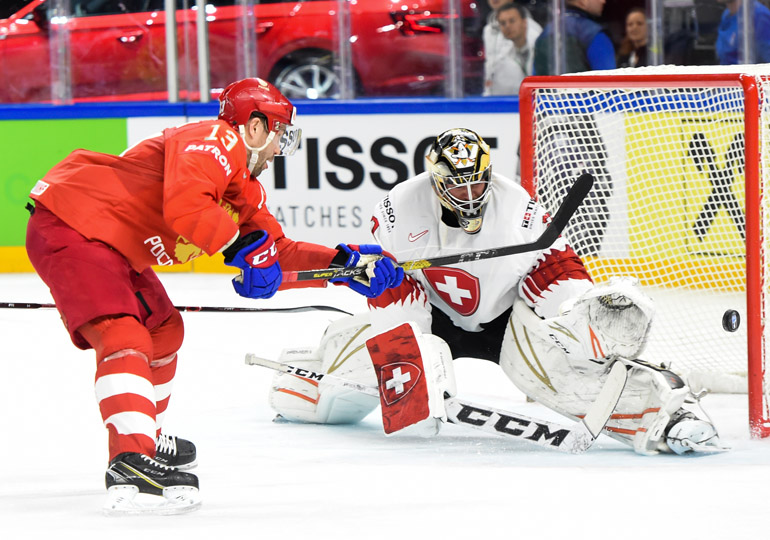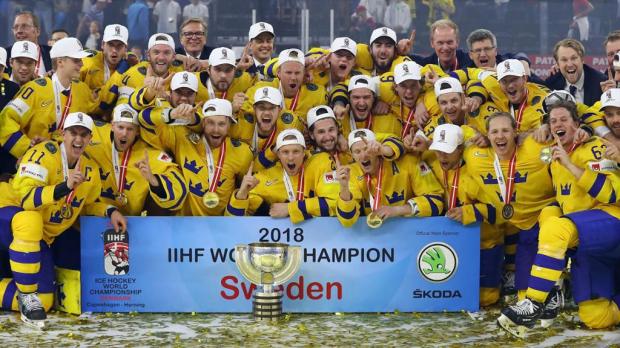If you have yet to read the previous post on my experience at the 2018 IIHF World Championship, click here.
As you might already know, I was bunked in Copenhagen for the 2018 IIHF World Championship. And even though I only watched a handful of matches in full, parts of a few more and barely anything that went down in Herning, I still want to collect a few takeaways from the tournament and each team I followed. Without further ado:
Austria
Immediately demoted following every previous top division appearance, the Austrians arrived in Copenhagen with a single goal in mind: avoid relegation at all costs. An achievement unlocked with flying colours after their resounding 4-0 triumph over Belarus in a do-or-die situation and, impressively, just 24 hours after a traumatic 2-5 loss against fellow relegation fodder France. It’s true that way back in their tournament opener Austria had surprisingly forced Switzerland to play overtime, escalating internal expectations, but more couldn’t have been asked from a team missing star forwards Thomas Vanek and Michael Grabner.
Eventually Philadelphia’s Michael Raffl showed up to infuse some NHL skill into the lineup, notching two eye-popping goals against the Czech and four in total, while veteran goalie Bernhard Starkbaum (91.79 Sv%, 2.72 GAA) authored some of the most spectacular desperation saves in the tournament, nonetheless the Austrian’s 14th place in the final standings is generally representative of their potential.

The Austrian players kneel to thank their fans for the support in the game against Belarus (new-iihf.com).
Belarus
A team in transition now that the Kostitsyn brothers and Mikhail Grabovski are being phased out, not many expected the Belarussians to bother the big nations like they’ve done at times in the past, yet their Danish nightmare went way deeper than that. Thrashed by France (6-2) between expected routs from Sweden and Russia, five days into the competition coach Dave Lewis was relieved off his duties, however the move didn’t rally the troops and the results continued to go from bad to worse, with that embarrassing defeat to Austria sealing their first relegation since 2003.
Madly inept in front of the goal, Belarus only scored 8 times in 7 games and half of those came in a washed out finale against Slovakia, where they provided their faithful with some semblance of hope, turning a 0-2 into a 4-3, before surrendering 4 straight Slovakian markers. Disastrous.

Belarus’ players react after their 7th and final loss at the 2018 IIHF World Championship.
Czech Republic
There was so much to like about Czech Republic’s performance in Copenhagen, so much promise, and they still headed home empty handed for the sixth consecutive year. Pushing the Swedes like few others did, and defeating Russia in a thriller, the Czech’s group prospects were eventually undone by the crucial points dropped in those early overtime encounters against Switzerland and Slovakia, forcing an extra trip to Herning and an unpredictable quarter-final with the USA decided by Patrick Kane’s genius.
Still, another last-eight exit couldn’t overshadow the confirmation of Pavel Francouz as one of Europe’s best goalies and a smart pickup by the Colorado Avalanche nor the heady play of a relatively anonymous blueline, where Detroit’s prospects Filip Hronek (20-year-old) and Libor Šulák (24) as well as newly-signed Montreal Canadien David Sklenička (21) shone. Moreover, up front, beyond the boost provide by David Pastrňák and David Krejčí, there was a lot to get Carolina Hurricanes’ fans excited about Martin Nečas (19), Vegas fans expectant about what Tomáš Hyka (25) can do in a bigger NHL spell and confidence-building performances by Dmitrij Jaškin(25) or Dominik Kubalík (22). After some bare years, the Czech revolution is underway and it’s a just a matter of time before they barge into the podium again. And how sweet looks the prospect of doing it in Slovakia next year?

Czech center Martin Nečas is chased by his teammates after scoring a late equalizer versus Slovakia.
France
After threatening to reach the quarters last year in Paris, there were natural aspirations regarding a possible second ever top-eight (2014) finish for France, however, despite a positive tournament, they never got particularly close. Hammered by Russia (0-7) in the first day, Les Bleus rebounded to handily best direct rivals Belarus (6-2) and Austria (5-2), yet they would have liked to cause more problems to the Czech (0-6) or the Swiss (1-5).
Taking into account that their two best forwards, Pierre-Édouard Bellemare and Antoine Roussel, didn’t don the sweater, Cristobal Huet is history, and the lack of alternatives to long-time mainstays such as Damien Fleury or the da Costa brothers is an inescapable reality, securing a 12th consecutive top division appearance in 2019 was not only an accomplishment but a nice way to bid adieu to retiring coach Dave Henderson.

France’s Jordann Perret reacts after scoring a goal on Belarus (Getty Images)
Russia
As I see it, you can evaluate Russia’s performance under two distinct prisms: they were without their five best players (Malkin, Kucherov, Tarasenko, Kuznetsov, Ovechkin) but still clinched second place in the group before falling in an hard-fought QF against Canada, which is obviously no shame and therefore qualifies Ilya Vorobyov’s first competition in charge as satisfactory. Or you could state that the Olympic Champions (…) dropped a winnable match against the Czech, were squarely beaten by Sweden and, once again, faltered in the moment of truth in a tournament they weren’t overwhelming favourites…
Not sure which option was favoured by Russian media, so I’ll just skip ahead and note that young Kirill Kaprizov put together another star-making performance in the international limelight, netting 6 goals in 8 games (Patience, Wild fans, exert patience), and together with Nikita Gusev and Pavel Datsyuk rekindled the magic of Pyeongchang to form the most dominant line seen in Copenhagen. Want another KHL player to keep tabs on? SKA St. Petersburg’s Alexander Barabanov, a skilled 23-year-old, bottom-six winger who posted 4 goals and 4 assists to turn scout’s heads aplenty.

Russia’s Pavel Datsyuk in action against Switzerland in a preliminary group match (Russian Ice Hockey Federation)
Slovakia
Just like their neighbours, Slovakia hasn’t medalled since 2012. Unlike the Czech, it’s difficult to anticipate that streak will be broken soon. Sure, the 9th place obtained in Denmark is an improvement over the disastrous 14th of 2017, but that shouldn’t be the standard for one of hockey’s traditional nations, which ought to get into the last eight regularly. Pipped to fourth place in Group A by virtue of a 0-2 defeat to the Swiss, the Slovaks showed fighting spirit against Sweden and the Czechs, failing both times in overtime, yet their well-documented struggles in graduating fresh blood into the national team setup were front and centre once again.
Goalie Marek Čiliak played decently, especially against the Czech, but he didn’t steal a game, the Slovak defence was still anchored by veteran Andrej Sekera – though it was nice to see draft-eligible Martin Fehérvary getting a test run – and the attack paced by the everlasting Ladislav Nagy, who posted 10 pts (5 against Belarus) as a 39-year-old top-line winger. With just two NHL players amongst their ranks (defenseman Christián Jaroš, from Ottawa, was the other), at least the tournament gave Tomáš Jurčo (4 goals) a chance to display some signs of life, with his raw skill sticking out from the mob.

Slovakia’s Tomáš Jurčo celebrates his goal against Austria (nhl.com)
Sweden
Preliminary round success in international play is a patented Swedish tradition and they delivered. After that, things naturally get trickier, but buoyed by the yellow wave that invaded Royal Arena, the Tre Kronor surfed high expectations in Copenhagen to end up seizing a second consecutive world title. Not that the Swedes were always overwhelming – Latvia, Slovakia and Switzerland can attest to that – however they managed to keep their nerve while trailing, continuing to pummel the opposition until they found a way to retake control of the proceedings.
And it helped, obviously, that their roster was brimming with established NHL talent and experience, headlined by the best defence corps in the tournament (Larsson, Ekman Larsson, Klingberg and Lindholm is a sick top-four) and a top forward line that clicked immediately, as Mattias Janmark (10 pts) managed to keep pace with Mika Zibanejad and Rikard Rakell (6 goals each). In any case, if that wasn’t enough firepower for opponents to deal with, Mattias Ekholm, Viktor Arvidsson, Filip Forsberg and Patric Hörnqvist soon disembarked directly from North America just to exacerbate the problem, and their supposed Achilles heel, the goaltending position, sorted itself out as Anders Nilsson ousted Magnus Hellberg’s competition before running away with Media All-Star honours (95.4, 1.09, 3 SO)..and the Cup.

Team Sweden listen to the national anthem after winning a match at the 2018 IIHF World Championship (REUTERS/Grigory Dukor)
Switzerland
Who would have thought the same Swiss team that struggled to squeak past Austria in their opener would eventually shock the hockey world two weeks later? In fact, not just once, which can be attributed to luck, but almost three straight times in a span of four days, upsetting established hockey nations with relentless team effort and discipline. Looking back though, the turning point for the Swiss might have been that tough back-to-back against Russia and Sweden (12/13 of May), when their battle level wasn’t enough to erase deficits but inspired belief.
Afterwards, the Swiss stomped France to book a place in the QF, raided Finland in a four-minute second period blitz, and built a Cinderella story that deserved a happy ending. It wasn’t meant to be, nonetheless Switzerland paved the road to success for mid-level nations: extract tremendous contributions from your NHL players (Timo Meier, Nino Niederreiter and Sven Andrighetto notched a point per game, Mirco Mueller stepped up in the medal round, late-arrivals Kevin Fiala and Roman Josi added a new dimension), ride a hot goalkeeper (Leonardo Genoni was immense vs Canada and Sweden) and – not least – unearth a few hidden gems along the way. For the Swiss, that was synonymous with defenseman Ramon Untersander (3 goals, 7 points), sneaky forward Gregory Hofmann (4 goals) and the tournament’s revelation, Enzo Corvi, the 25-year-old HC Davos center who rode shotgun with Niederreiter and scored a beauty of an overtime winner against Austria.

Jubilant Swiss players get together to celebrate victory over Canada in the semi-final of the 2018 IIHF World Championship (Getty Images)
Canada
Connor McDavid is unlikely to be available for the Worlds for much of the next 15 years (right, Edmonton?) and the Canadians, to put it simple, blew away a great opportunity to level Russia’s (including Soviet Union) record tally of 27 gold medals in the competition. Evidently not due to the young phenomenon’s efforts, since he piled up the points (17 in 10 matches), scored an hat-trick on the Norwegians and an overtime winner that avoided embarrassment versus Latvia, but it’s still a fact that McDavid didn’t exactly rip the opposition to shreds in the playoff round. This in spite of the three assists against Russia, followed up by a frustrating match versus the Swiss, and the disappearing act in the team’s putrid effort on a bronze medal contest that epitomized Canada’s tournament, one with more valleys than peaks.
Still, positive grades go out to Aaron Ekblad and Colton Parayko (that cannon of a shot is a sight to behold) and all the question marks are reserved for Canada’s entire goaltending situation: a tandem of Darcy Kuemper (awful performance) and Curtis McElhinney (serviceable…)? No comments. Except we’ll take the time to report the name of Canada’s third string goalie: Michael Di Pietro. Who?

Canadians Connor McDavid, Ryan O’Reilly and Aaron Ekblad celebrate victory over Russia at the World Championship quarter-finals (Getty Images)
Latvia
Why, Latvia? Who allowed you free reign to destroy our beautiful dream, a Sweden-Denmark quarter-final? I’ll only forgive you because Latvian hockey fans are awesome and your goalies have a penchant for creating chaos. How else can we explain the fact unheralded Kristers Gudļevskis put a scare into the Canadian hearts again? Or that Elvis Merzļikins – great name, greater numbers (94.04 Sv%, 1.50 GAA, 2 SO) – shut down Denmark, forced the USA to OT and came pretty close from doing the same to the almighty Swedes?
USA
For once the Americans didn’t tank a bronze medal game! Because they still felt the sting of their semi-final debacle? Maybe. Because they cherish every opportunity to get an upper-hand on the Canadians? A bit. But I prefer to believe they badly wanted to honour Jim Johannson, the USA Hockey mainstay and mentor who unexpectedly passed away in January at age 53.
In an emotive ceremony, John Johannson, Jim’s brother, handed out the bronze medals to the American players and, afterwards, they all expressed their profound esteem for the man, yet they should know the best way to preserve his legacy at USA Hockey is to follow Patrick Kane’s lead: show up every May with a strong, committed group and establish the Americans as a force to be reckoned at the World Championships too. This was another step, as no one scored as much as the USA (46 goals) or picked up more points than Kane (20), the tournament MVP, but to claim a World title in the future, they’ll have to clean up the type of lacklustre performances that caused Finland and Sweden to pump six goals into Keith Kinkaid’s net.

Nick Bonino of the U.S. scores a goal in the bronze-medal match (REUTERS/Grigory Dukor)
Finland
The mystifying tales of a talented Finnish duo that was setting Herning on fire didn’t take long to reach the Danish Capital, and just as I rubbed my hands in anticipation of the incoming circus, the party was over. Forty goals in eight games, demolitions of Canada (5-1) and the USA (6-2) interspersed by head-scratching losses to Denmark and Germany. Of course, Finland would have to draw their worst version against Switzerland. Still, 18 pts for Sebastian Aho (9 goals!) and 14 (5+9) for Teuvo Teräväinen, with the Hurricanes’ duo combining for a +29 rating in just 8 games? Absurd.
Denmark
It’s fair to call Denmark’s tournament a(n on-ice) failure. Quarter-Finalists in 2010 and 2016, they were dumped out, on home soil, by tiny Latvia in a winner-takes-all preliminary finale contested days after, predictably, achieving the most difficult: overcome Olympic silver medallists Germany and steal three points from the high-flying Finns.
It’s true that Denmark’s most explosive offensive weapons, Nikolaj Ehlers and Lars Eller, were still involved in the NHL playoffs, but the hosts still boasted the majority of their stalwarts (Frans Nielsen, Oliver Bjorkstrand, Mikkel Bødker, Jannik Hansen) and none could buy a single goal against Latvia. Frederik Andersen, their joker, did all he could (94.38 Sv%, 1.65 GAA) on the other end and his titanic effort still went to waste. Bah.

Goalie Frederik Andersen leads Team Denmark’s salute to the public of Herning after the victory over Finland on May 9th (Martin Rose/Getty Images Europe)
Nothing to report: Germany, Norway, North Korea












